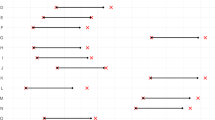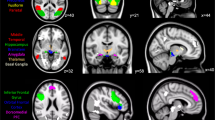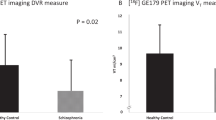Abstract
Serotonin transporter (5-HTT) binding deficits are reported in major depressive disorder (MDD). However, most studies have not considered serotonin system anatomy when parcellating brain regions of interest (ROIs). We now investigate 5-HTT binding in MDD in two novel ways: (1) use of a 5-HTT tract-based analysis examining binding along serotonergic axons; and (2) using the Copenhagen University Hospital Neurobiology Research Unit (NRU) 5-HT Atlas, based on brain-wide binding patterns of multiple serotonin receptor types. [11C]DASB 5-HTT PET scans were obtained in 60 unmedicated participants with MDD in a current depressive episode and 31 healthy volunteers (HVs). Binding potential (BPP) was quantified with empirical Bayesian estimation in graphical analysis (EBEGA). Within the [11C]DASB tract, the MDD group showed significantly lower BPP compared with HVs (p = 0.02). This BPP diagnosis difference also significantly varied by tract location (p = 0.02), with the strongest MDD binding deficit most proximal to brainstem raphe nuclei. NRU 5-HT Atlas ROIs showed a BPP diagnosis difference that varied by region (p < 0.001). BPP was lower in MDD in 3/10 regions (p-values < 0.05). Neither [11C]DASB tract or NRU 5-HT Atlas BPP correlated with depression severity, suicidal ideation, suicide attempt history, or antidepressant medication exposure. Future studies are needed to determine the causes of this deficit in 5-HTT binding being more pronounced in proximal axon segments and in only a subset of ROIs for the pathogenesis of MDD. Such regional specificity may have implications for targeting antidepressant treatment, and may extend to other serotonin-related disorders.
This is a preview of subscription content, access via your institution
Access options
Subscribe to this journal
Receive 12 print issues and online access
$259.00 per year
only $21.58 per issue
Buy this article
- Purchase on Springer Link
- Instant access to full article PDF
Prices may be subject to local taxes which are calculated during checkout




Similar content being viewed by others
References
Owens MJ, Nemeroff CB. Role of serotonin in the pathophysiology of depression: focus on the serotonin transporter. Clin Chem. 1994;40:288–95.
Gryglewski G, Lanzenberger R, Kranz GS, Cumming P. Meta-analysis of molecular imaging of serotonin transporters in major depression. J Cereb Blood Flow Metab. 2014;34:1096–103.
Kambeitz JP, Howes OD. The serotonin transporter in depression: meta-analysis of in vivo and post mortem findings and implications for understanding and treating depression. J Affect Disord. 2015;186:358–66.
Parsey RV, Hastings RS, Oquendo MA, Huang Y-Y, Simpson N, Arcement J, et al. Lower serotonin transporter binding potential in the human brain during major depressive episodes. Am J Psychiatry. 2006;163:52–8.
Selvaraj S, Murthy NV, Bhagwagar Z, Bose SK, Hinz R, Grasby PM, et al. Diminished brain 5-HT transporter binding in major depression: a positron emission tomography study with [11 C] DASB. Psychopharmacology. 2011;213:555–62.
Malison RT, Price LH, Berman R, Van Dyck CH, Pelton GH, Carpenter L, et al. Reduced brain serotonin transporter availability in major depression as measured by [123I]-2β-carbomethoxy-3β-(4-iodophenyl) tropane and single photon emission computed tomography. Biol Psychiatry. 1998;44:1090–8.
Joensuu M, Tolmunen T, Saarinen PI, Tiihonen J, Kuikka J, Ahola P, et al. Reduced midbrain serotonin transporter availability in drug-naive patients with depression measured by SERT-specific [123I] nor-β-CIT SPECT imaging. Psychiatry Res Neuroimaging. 2007;154:125–31.
Reimold M, Batra A, Knobel A, Smolka M, Zimmer A, Mann K, et al. Anxiety is associated with reduced central serotonin transporter availability in unmedicated patients with unipolar major depression: a [11 C] DASB PET study. Mol Psychiatry. 2008;13:606–13.
Staley JK, Sanacora G, Tamagnan G, Maciejewski PK, Malison RT, Berman RM, et al. Sex differences in diencephalon serotonin transporter availability in major depression. Biol Psychiatry. 2006;59:40–7.
Willeit M, Praschak-Rieder N, Neumeister A, Pirker W, Asenbaum S, Vitouch O, et al. [123I]-β-CIT SPECT imaging shows reduced brain serotonin transporter availability in drug-free depressed patients with seasonal affective disorder. Biol Psychiatry. 2000;47:482–9.
Lehto S, Tolmunen T, Joensuu M, Saarinen PI, Vanninen R, Ahola P, et al. Midbrain binding of [123I] nor-β-CIT in atypical depression. Prog Neuro-Psychopharmacol Biol Psychiatry. 2006;30:1251–5.
Nye JA, Purselle D, Plisson C, Voll RJ, Stehouwer JS, Votaw JR, et al. Decreased brainstem and putamen SERT binding potential in depressed suicide attempters using [11C]‐ZIENT pet imaging. Depression Anxiety. 2013;30:902–7.
Cannon DM, Ichise M, Fromm SJ, Nugent AC, Rollis D, Gandhi SK, et al. Serotonin transporter binding in bipolar disorder assessed using [11C] DASB and positron emission tomography. Biol Psychiatry. 2006;60:207–17.
Meyer JH, Wilson AA, Ginovart N, Goulding V, Hussey D, Hood K, et al. Occupancy of serotonin transporters by paroxetine and citalopram during treatment of depression: a [11C] DASB PET imaging study. Am J Psychiatry. 2001;158:1843–9.
Meyer JH, Houle S, Sagrati S, Carella A, Hussey DF, Ginovart N, et al. Brain serotonin transporter binding potential measured with carbon11–labeled dasb positron emission tomography: Effects of major depressive episodes and severity of dysfunctionalattitudes. Arch Gen Psychiatry. 2004;61:1271–9.
Miller JM, Hesselgrave N, Ogden RT, Sullivan GM, Oquendo MA, Mann JJ, et al. Positron emission tomography quantification of serotonin transporter in suicide attempters with major depressive disorder. Biol Psychiatry. 2013;74:287–95.
Ichimiya T, Suhara T, Sudo Y, Okubo Y, Nakayama K, Nankai M, et al. Serotonin transporter binding in patients with mood disorders: a PET study with [11C](+) McN5652. Biol Psychiatry. 2002;51:715–22.
Soares JC, Mann JJ. The functional neuroanatomy of mood disorders. J Psychiatr Res. 1997;31:393–432.
Innis RB, Cunningham VJ, Delforge J, Fujita M, Gjedde A, Gunn RN, et al. Consensus nomenclature for in vivo imaging of reversibly binding radioligands. J Cereb Blood Flow Metab. 2007;27:1533–9.
Frankle WG, Huang Y, Hwang D-R, Talbot PS, Slifstein M, Van Heertum R, et al. Comparative evaluation of serotonin transporter radioligands 11C-DASB and 11C-McN 5652 in healthy humans. J Nucl Med. 2004;45:682–94.
Beliveau V, Ozenne B, Strother S, Greve DN, Svarer C, Knudsen GM, et al. The structure of the serotonin system: a PET imaging study. Neuroimage. 2020;205:116240.
Beliveau V, Ganz M, Feng L, Ozenne B, Højgaard L, Fisher PM, et al. A high-resolution in vivo atlas of the human brain’s serotonin system. J Neurosci. 2017;37:120–8.
Gopaldas M, Zanderigo F, Zhan S, Ogden RT, Miller JM, Rubin-Falcone H, et al. Brain serotonin transporter binding, plasma arachidonic acid and depression severity: a positron emission tomography study of major depression. J Affect Disord. 2019;257:495–503.
Yeh Y-W, Ho P-S, Chen C-Y, Kuo S-C, Liang C-S, Yen C-H, et al. Suicidal ideation modulates the reduction in serotonin transporter availability in male military conscripts with major depression: a 4-[18F]-ADAM PET study. World J Biol Psychiatry. 2015;16:502–12.
Ogden RT, Ojha A, Erlandsson K, Oquendo MA, Mann JJ, Parsey RV. In vivo quantification of serotonin transporters using [(11)C]DASB and positron emission tomography in humans: modeling considerations. J Cereb Blood Flow Metab. 2007;27:205–17.
Miller JM, Everett BA, Oquendo MA, Ogden RT, Mann JJ, Parsey RV. Positron emission tomography quantification of serotonin transporter binding in medication‐free bipolar disorder. Synapse. 2016;70:24–32.
Parsey RV, Kent JM, Oquendo MA, Richards MC, Pratap M, Cooper TB, et al. Acute occupancy of brain serotonin transporter by sertraline as measured by [11C]DASB and positron emission tomography. Biol Psychiatry. 2006;59:821–8.
First MB, Gibbon M, Spitzer RL, Williams JB, Benjamin LS. SCID-II Personality Questionnaire. Washington, D.C.: American Psychiatric Press; 1997.
Beck AT, Ward CH, Mendelson M, Mock J, Erbauh J. An inventory for measuring depression. Arch Gen Psychiatry. 1961;4:53–63.
Hamilton M. A rating scale for depression. J Neurol Neurosurg Psychiatry. 1960;23:56–62.
Oquendo MA, Halberstam B, Mann JJ. Risk factors for suicidal behavior: the utility and limitations of research instruments. In: First MB, editor. Standardized Evaluation in Clinical Practice. Arlington, VA: American Psychiatric Publishing; 2003. p. 103–30.
Beck AT, Kovacs M, Weissman A. Assessment of suicidal intention: the Scale for Suicide Ideation. J Consulting Clin Psychol. 1979;47:343.
Belanger MJ, Simpson NR, Wang T, Van Heertum R, Mann JJ, Parsey RV. Biodistribution and Radiation Dosimetry of [11C]DASB in Baboons. Nucl Med Biol. 2004;31:1097–102.
Parsey RV, Slifstein M, Hwang DR, Abi-Dargham A, Simpson N, Mawlawi O. et al. Validation and reproducibility of measurement of 5-HT1A receptor parameters with [carbonyl-11C]WAY-100635 in humans: comparison of arterial and reference tisssue input functions. J Cereb Blood Flow Metab. 2000;20:1111–33.
Zanderigo F, Ogden RT, Bertoldo A, Cobelli C, Mann JJ, Parsey RV. Empirical Bayesian estimation in graphical analysis: a voxel-based approach for the determination of the volume of distribution in PET studies. Nucl Med Biol. 2010;37:443–51.
Zanderigo F, Mann JJ, Ogden RT. A hybrid deconvolution approach for estimation of in vivo non-displaceable binding for brain PET targets without a reference region. PLoS ONE. 2017;12:e0176636.
Hornung J-P. The neuronatomy of the serotonergic system. Handbook of Behavioral Neuroscience. Elsevier; 2010. vol. 21. p. 51–64..
Charnay Y, Léger L. Brain serotonergic circuitries. Dialogues Clin Neurosci. 2010;12:471.
Törk I. Anatomy of the Serotonergic System a. Ann N Y Acad Sci. 1990;600:9–34.
Wang J-L, Chiou J-M, Müller H-G. Functional data analysis. Annu Rev Stat Appl. 2016;3:257–95.
Bates D, Mächler M, Bolker B, Walker S. Fitting linear mixed-effects models using lme4. arXiv preprint arXiv:14065823. 2014.
Team RC. R: A language and environment for statistical computing. Vienna: Austria; 2013.
Heils A, Teufel A, Petri S, Stöber G, Riederer P, Bengel D, et al. Allelic variation of human serotonin transporter gene expression. J Neurochem. 1996;66:2621–4.
Lesch K-P, Bengel D, Heils A, Sabol SZ, Greenberg BD, Petri S, et al. Association of anxiety-related traits with a polymorphism in the serotonin transporter gene regulatory region. Science. 1996;274:1527–31.
Arango V, Underwood MD, Boldrini M, Tamir H, Kassir SA, Hsiung S. et al. Serotonin 1A receptors, serotonin transporter binding and serotonin transporter mRNA expression in the brainstem of depressed suicide victims. Neuropsychopharmacology. 2001;25:892–903.
Parsey RV, Hastings RS, Oquendo MA, Hu X, Goldman D, Huang Y-Y, et al. Effect of a triallelic functional polymorphism of the serotonin-transporter-linked promoter region on expression of serotonin transporter in the human brain. Am J Psychiatry. 2006;163:48–51.
Güzey C, Allard P, Brännström T, Spigset O. Radioligand binding to brain dopamine and serotonin receptors and transporters in Parkinson’s disease: relation to gene polymorphisms. Int J Neurosci. 2012;122:124–32.
Reimold M, Smolka M, Schumann G, Zimmer A, Wrase J, Mann K, et al. Midbrain serotonin transporter binding potential measured with [11 C] DASB is affected by serotonin transporter genotype. J Neural Transm. 2007;114:635–9.
Praschak-Rieder N, Kennedy J, Wilson AA, Hussey D, Boovariwala A, Willeit M, et al. Novel 5-HTTLPR allele associates with higher serotonin transporter binding in putamen: a [11C] DASB positron emission tomography study. Biol Psychiatry. 2007;62:327–31.
Albert PR, Benkelfat C. The neurobiology of depression—revisiting the serotonin hypothesis. II. Genetic, epigenetic and clinical studies. The Royal Society; 2013.
Kinnally EL, Capitanio JP, Leibel R, Deng L, LeDuc C, Haghighi F, et al. Epigenetic regulation of serotonin transporter expression and behavior in infant rhesus macaques. Genes, Brain Behav. 2010;9:575–82.
Oquendo MA, Galfalvy H, Sullivan GM, Miller JM, Milak MM, Sublette ME, et al. Positron emission tomographic imaging of the serotonergic system and prediction of risk and lethality of future suicidal behavior. JAMA Psychiatry. 2016;73:1048–55.
Wise RA. Dopamine, learning and motivation. Nat Rev Neurosci. 2004;5:483–94.
Kalivas PW, Nakamura M. Neural systems for behavioral activation and reward. Curr Opin Neurobiol. 1999;9:223–7.
Oades RD, Halliday GM. Ventral tegmental (A10) system: neurobiology. 1. Anatomy and connectivity. Brain Res Rev. 1987;12:117–65.
Hervé D, Pickel VM, Joh TH, Beaudet A. Serotonin axon terminals in the ventral tegmental area of the rat: fine structure and synaptic input to dopaminergic neurons. Brain Res. 1987;435:71–83.
Van Bockstaele EJ, Cestari DM, Pickel VM. Synaptic structure and connectivity of serotonin terminals in the ventral tegmental area: potential sites for modulation of mesolimbic dopamine neurons. Brain Res. 1994;647:307–22.
Neurocircuitry of mood disorders. Proceedings of the In Neuropsychopharmacology: The Fifth Generation of Progress; 2002. Citeseer.
Wang H-L, Zhang S, Qi J, Wang H, Cachope R, Mejias-Aponte CA, et al. Dorsal raphe dual serotonin-glutamate neurons drive reward by establishing excitatory synapses on VTA mesoaccumbens dopamine neurons. Cell Rep. 2019;26:1128–42. e1127
Svensson JE, Svanborg C, Plavén-Sigray P, Kaldo V, Halldin C, Schain M, et al. Serotonin transporter availability increases in patients recovering from a depressive episode. Transl Psychiatry. 2021;11:1–10.
Acknowledgements
This work was supported by the National Institute of Mental health (P50MH090964, PI: J John Mann, MD and 5R01MH040695, PI: J John Mann, MD).
Author information
Authors and Affiliations
Contributions
EAB: methodology, software, formal analysis, validation, writing – original draft, and visualization; FZ: conceptualization, methodology, writing – review and editing, and supervision; DS: formal analysis, data curation, validation, visualization, and writing – review and editing; JM: conceptualization, data curation, investigation, supervision, project administration, and writing – review and editing; PH: methodology and writing – review and editing; HRF: methodology, software, validation, formal analysis, data curation, and writing – original draft; MAO: conceptualization, supervision, and writing – review and editing; MES: conceptualization, supervision, writing – review and editing, investigation, and project administration; RTO: conceptualization, methodology, validation, formal analysis, supervision, writing – review and editing; JJM: conceptualization, investigation, resources, supervision, project administration, funding acquisition, and writing – review and editing.
Corresponding author
Ethics declarations
Conflict of interest
EAB, FZ, JM, PH, MES, TO, DS, and HRF declare no conflict of interest. MAO and JJM receive royalties from the Research Foundation for Mental Hygiene for the commercial use of the Columbia Suicide Severity Rating Scale. MAO serves as an advisor to Alkermes, Otsuka, ATAI, St. George’s University and Fundacion Jimenez Diaz. Her family owns stock in Bristol Myers Squibb.
Additional information
Publisher’s note Springer Nature remains neutral with regard to jurisdictional claims in published maps and institutional affiliations.
Supplementary information
Rights and permissions
About this article
Cite this article
Bartlett, E.A., Zanderigo, F., Shieh, D. et al. Serotonin transporter binding in major depressive disorder: impact of serotonin system anatomy. Mol Psychiatry 27, 3417–3424 (2022). https://doi.org/10.1038/s41380-022-01578-8
Received:
Revised:
Accepted:
Published:
Issue Date:
DOI: https://doi.org/10.1038/s41380-022-01578-8



